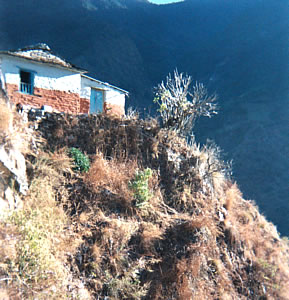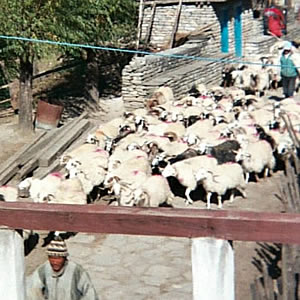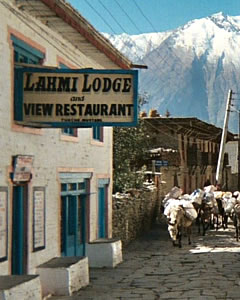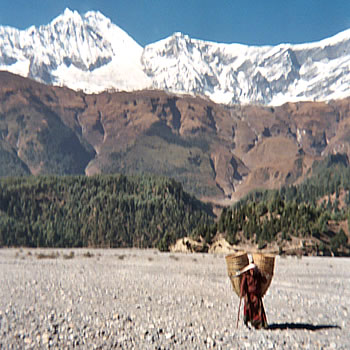| |
Tuesday,
November 18
From Marpha to Kalopani
The
next morning my towel was dry. A good omen. I got in a quick
shave at the sink in the hot water shower room. We had some
porridge and Tibetan bread, which was fried bread made in
a skillet. Not bad. We got off to a reasonably early start.
I was a little sad to leave lovely Marpha behind. But before
we had gotten far, Krishna had us stop at the gates of an
agricultural station run by the government. Within the gates
were rows of apple trees and a few other fruit trees including
apricot. And there were vegetable gardens. A man took us into
one of the buildings and showed us an old distillery where
the apple brandy was made. Krishna bought a couple of one
liter plastic jugs of the stuff and added it to their burden
to carry. He said he was taking it back to his father and
father in law. However, due to Bira, not all of it reached
them. Krishna also bought bags of dried apple slices which
were delicious, the best I have ever tasted. And despite my
diarrhea-avoidance strategy of refusing uncooked fruits and
vegetables, I ate fresh apples. And they, too, were delicious.
Eventually we set
out again, with the day's destination being a village by the
name of Kalopani. I had been improving my pronunciation and
learning a few more words of Nepali from Krishna. What does
pani mean, I asked him, because a lot of these village names
end in it. It means water, he said. Like Tatopani, tato means
hot and pani means water, and there is a hot spring there.
This was when I made my only joke in Nepali. I think we should
call Muktinath (where we had spent our miserable first night)
Cheesopani, I told him. I knew that cheeso means cold, a reference
to the available but untested cold shower in that frigid village.

The trek to Kalopani
was brutal in its own way, and as always, different from yesterday's.
It started on a trail, which fed us into the riverbed again.
But the wind wasn't so bad. After some time we came upon these
flimsy bark covered houses on the riverbed, with corrals outside
and sometimes numerous horses. They reminded me of what I
imagine a pony express station to be like. Tired ponies rest
and load the freight on a fresh pony and move on. I think
that's what one of them was. Krishna said these were winter
houses, where these people live in the winter. It occurred
to me that the river would prohibit them being there in the
rainy season, so maybe they are flimsy because they move them.
We were resting at one when a woman came walking along the
riverbed, which extended seemingly endlessly in both directions.
She was carrying two big conical baskets on her back, and
they looked heavy. But I wasn't sure what was in them. She
was just one of many people we passed who carried heavy burdens
over difficult terrain for amazing distances. In fact, Krishna
himself had done this for a few years, and that is how he
had learned the trails. Later he took the training to become
a certified guide. But this experience was partly the basis
of the wisdom of his feet. You could never go wrong following
Krishna and putting your feet where his had gone.
For some time we
crossed the river by hopping from rock to rock. But eventually
we got to a place where there was no bridge and there were
no rocks above the water, which was less than knee deep. This
is where we carry you across, Krishna said. We said, no, we'll
take off our boots and wade across. Look, this is what we
do, so just let us do it, they said. So we did. Lila first
took his pack across and then returned for me. He had me lace
my fingers together and hold onto his forehead like a tump
line, and he carried me on his back. It was fairly hilarious
to see Andy carried by Bira, who probably weighed about half
as much as Andy.
We climbed up off
the riverbed and trekked on a trail that ran along the river,
along the mountain sides. Of all the days of the trek, this
was probably the easiest physically. And all day the white
peaks of the Annapurnas traveled with us, or so it seemed,
like they were always looking at us over the shoulders of
closer mountains.
Lunch that day, between
Marpha and Kalopani, we had on a second floor terrace overlooking
the main street of a village. I should mention that the menus
at these places include damn near everything, including Italian
food and Mexican, etc. Food for trekkers. If you order something
like that, you expect it to be a little different, since the
people probably don't have the exact ingredients or experience.
Rob and Krishna and I had dahl bat, which was ok but not very
hot. Andy ordered a bean burrito, and we were long finished
with our food and sitting there still waiting for his. A flock
of sheep appeared, being driven down the main street of town.
They all had magenta dye on their hindquarters where they
had been treated with insecticide.

They literally packed
into the street and blocked it, and it took quite a while
to get them moving on through town. Finally, the burrito came.
It had been very carefully made from something like a big
chapatti and kidney beans, but I didn't taste it. Andy said
it was the best thing he'd had to eat on the trek.
What is it that makes
trekking such a wonderful experience? I know I haven't revealed
it here. It is a synergy of various things, including traveling
under your own power, being in a new and wildly different
place, and the rhythm and physical exertion and cultural challenges
and the people you meet or even just see and greet along the
way, the glimpses into their amazing faces and lives. And
the experiences shared with your companions. And the food
and the sunrises and sunsets on the snowy peaks and the little
villages and the rhythm of life in those villages and on the
farms you pass, and having the time to experience them some
instead of flying over them or whizzing past them in a car.
Soaking in the smells, the tastes, the feel of the place.
And Nepal has a good feel, a friendly feel.
Kalopani is a small
village, but the guest house was reasonably nice. Our rooms
were on the second floor, as they always seemed to be. The
shower and toilet facilities were the best so far. Not only
was there warm water, you could actually adjust the temperature!
After we got settled, Krishna took us over to a school, which
does technical training and boards the young students who
attend.

At dinner, we sat
with some Australians and Europeans and shared the warmth
under the table and conversation about what to expect. We
had been where some of them were going, and of course they
had been where we were going. There was a discussion of the
Maoists at Ghorepani, and we expected to encounter them in
a couple of days. Several people at the table had terrible
coughs. I had encountered a lot of travelers who were sick,
and I was in the later stages of a cold myself. We lingered
and the boys played cards and I read my book, Cold Mountain,
appropriately enough.
When we went to our
rooms, I lay in my cozy sleeping bag and soon realized that
the walls were absurdly thin. The people in the next room
sounded like they were in the next bed. I could clearly hear
people several beds away. And they were doing more than coughing.
But another great thing about trekking is the ease with which
sleep comes. During the night I got up to head down to the
toilet, and I lingered on the balcony to watch the stars.
They were spectacular.
The
next day
this
travelogue is part of the subside
travelzine
about bookshelf
links contact
submit
|
|



